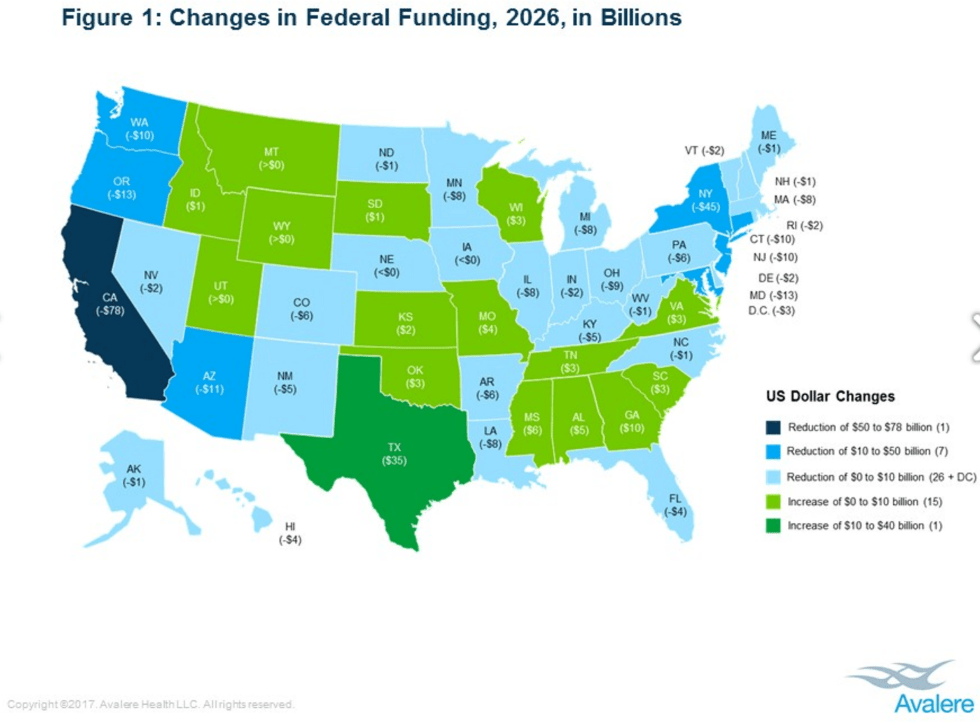34 states would see funding cut from new ObamaCare repeal bill: study
The newest legislation to repeal and replace ObamaCare would slash federal funding to states by $215 billion by 2026 and cut more than $4 trillion over a 20-year period, according to a new analysis.
The analysis by the nonpartisan consulting firm Avalere Health found that by 2026, the legislation would lead to 34 states and the District of Columbia experiencing funding cuts.
Seven of those states would see cuts of more than $10 billion and 16 states would see a funding increase. The biggest losers would be states that expanded Medicaid under ObamaCare.
“States would have broad flexibility to shape their markets but would have less funding to subsidize coverage for low- and middle-income individuals,” Caroline Pearson, senior vice president at Avalere, said in a statement.
{mosads}
The newest repeal effort, co-sponsored by Sens. Lindsey Graham (R-S.C.) and Bill Cassidy (R-La.), would largely dismantle ObamaCare and convert its funding to block grants to states, empowering them to design new programs.
Cassidy, Graham and the other co-sponsors of the bill said the legislation is about fairness. It aims to redistribute money from high-spending Medicaid expansion states — like California — to states that rejected the expansion — like Texas.
But it isn’t just blue states that stand to lose under the Graham-Cassidy proposal.
Sens. John McCain (R-Ariz.) and Lisa Murkowski (R-Alaska) could decide the fate of the bill. Arizona, which expanded Medicaid, would lose $19 billion by 2027. Alaska is also an expansion state and would lose $2 billion.
McCain, Murkowski and Sen. Susan Collins (R-Maine) sank the last GOP effort to repeal ObamaCare. Maine, which did not accept Medicaid expansion, would also lose $2 billion under the bill, according to Avalere.
With Sen. Rand Paul (R-Ky.) saying he is voting no and Collins thought to be a likely opponent, the bill would need both McCain and Murkowski to vote yes, allowing Vice President Pence to break a tie.
Avalere’s analysis is one of the only independent studies that has been conducted since the bill was introduced last week. The Congressional Budget Office said it will only be able to offer a preliminary analysis by next week.
The CBO won’t be able to analyze the impact on health insurance coverage or premiums for at least several weeks. That is longer than the timetable the Senate is working with.
The Senate is rushing to vote by Sept. 30 so the bill’s special reconciliation status — which would prevent a Democratic filibuster requiring 60 votes to break — doesn’t expire.
Avalere also notes the impact of the bill’s funding cliff. Under Graham-Cassidy, the block grant appropriations end after 2026. It’s not clear whether Congress would be able to fully appropriate the grants again or if they would want to.
So, by 2027, 39 states and D.C. would face funding cuts, with 18 states seeing reductions of greater than $10 billion.
Only 11 states would see an increase. Through 2027, the bill would reduce total federal funding to states by $489 billion.
By 2036, every state would lose money, ranging from a $4 billion loss in South Dakota to $800 billion in California.


Copyright 2024 Nexstar Media Inc. All rights reserved. This material may not be published, broadcast, rewritten, or redistributed..







